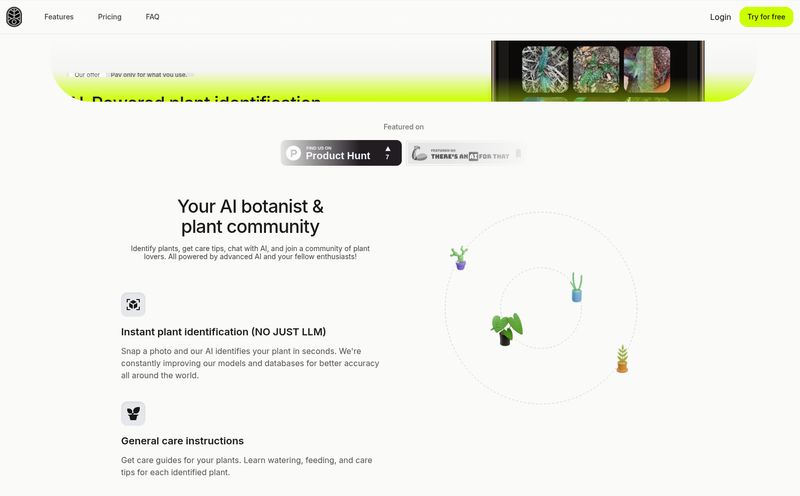We've all been there. You spend weeks, maybe months, burying your nose in grammar books and Duolingo lessons. You can conjugate verbs in your sleep and your vocabulary flashcard stack is a legitimate fire hazard. But then, the moment of truth arrives. A native speaker asks you a simple question, and your brain just… bluescreens. All that knowledge vanishes, replaced by a jumble of panic and the single, coherent thought: “Uh… sí?”
The gap between knowing a language and using a language is a canyon. The only way to cross it is to build a bridge, conversation by conversation. But that's the hard part, right? Finding someone to practice with, coordinating schedules across timezones, and getting over the crippling fear of sounding like a complete idiot. It’s a huge bottleneck for so many aspiring polyglots.
So when I stumbled upon Tandem GPT, I was intrigued. The promise? An AI language partner, ready to chat 24/7. No judgment, no scheduling, no awkward silences. Just practice. It almost sounded too good to be true. But here’s the thing that really caught my eye: it wasn’t made by some giant, faceless corporation. It was built by two guys, Juan and Felipe, a couple of Colombian engineers in Austria who were facing the exact same struggle trying to learn German. They built the tool they wished they had. And honestly? That's the kind of story that gets me to click “Try for free.”
So, What Is Tandem GPT, Really?
At its heart, Tandem GPT is a conversation simulator. Think of it less as a chatbot that answers questions and more as a conversational sparring partner. Its entire purpose is to help you rehearse real-life conversations in the language you're learning. You’re not just typing words into a box; you’re engaging in a dynamic back-and-forth designed to mimic how people actually talk.
The platform lets you jump into pre-made scenarios—like ordering food or checking into a hotel—or, and this is the cool part, create your own. Need to practice for a job interview in French? Or maybe you want to rehearse haggling at a market in Spanish? You can literally build that exact scenario and practice it until it feels second nature. It’s about building muscle memory for your mouth and your brain.

Visit Tandem GPT
The Features That Actually Matter
Any new tool is only as good as its features. After playing around with Tandem GPT, a few things really stood out as being more than just marketing fluff. These are the elements that I think make a real difference in the learning process.
Practice Anytime, No Awkward Scheduling Needed
This is the most obvious benefit, but it cannot be overstated. The AI is always on. Whether you're a night owl who gets a burst of inspiration at 2 AM or you just want to squeeze in 15 minutes of practice on your lunch break, your AI partner is ready. No more trying to find a time that works for you and a partner in a different hemisphere. The friction is just… gone.
More Than Just Texting: The Power of Voice
Okay, this is a big one. Tandem GPT supports voice messaging. For anyone serious about fluency, this is a game-changer. You can't hide behind typos or perfectly crafted text messages. You have to actually speak. You get to practice your accent, your intonation, the rhythm of the language. The AI responds in kind, letting you hear the language spoken naturally. This is how you move from sounding like a textbook to sounding like a person.
Setting the Scene: Custom & Pre-made Scenarios
I touched on this before, but it deserves its own moment. The pre-established scenarios are great for beginners. They provide a scaffold, a safe space to try out common situations. But the ability to create your own scenarios is where the magic happens for intermediate and advanced learners. You can tailor the practice to your specific needs. It transforms the tool from a generic language app into your own personal language-learning laboratory. You’re not just learning the language; you’re learning to use it in contexts that matter to you.
My Honest Take: The Good, The Bad, and The AI
Alright, let's get down to it. No tool is perfect, and my job is to give you the unvarnished truth. I’ve been in the SEO and digital tools space for years, and I’ve seen my share of hype. So how does Tandem GPT stack up?
The wins are pretty clear. The convenience is off the charts. The no-judgment zone it creates is incredible for building confidence. I found myself trying out more complex sentences and vocabulary simply because I knew a robot wouldn't laugh at me if I messed up. Those little progress stats they show—like +8,000 conversations started—add a nice bit of social proof and a feeling of being part of something growing.
But what about the caveats? The biggest question is always about the AI itself. Is it as good as a real person? No, of course not. An AI can't catch the subtle nuances of culture, sarcasm, or the intricate dance of human conversation perfectly. It won't correct your grammar with the finesse of a seasoned teacher or share a personal anecdote that makes a new phrase stick forever. It's a simulator, and we have to remember that. There's also the risk of it becoming a crutch. If you only practice with the AI, you might delay the inevitable—and necessary—leap into real-world conversations. You gotta eventually take the training wheels off the bike.
Who Is This Really For?
I see Tandem GPT as being a perfect fit for a few types of learners:
- The Anxious Beginner: If the thought of speaking to a native speaker makes you break out in a cold sweat, this is your safe harbor. Build your confidence here first.
- The Intermediate Learner in a Rut: You know the grammar, you have the vocab, but you're not progressing. Use this to practice specific, challenging scenarios and break through that plateau.
- The Busy Professional: If your schedule is chaotic, this is your solution. Practice on the train, during your coffee break, whenever you have a spare moment.
It might not be the primary tool for an advanced speaker who needs deep, philosophical debates to sharpen their skills, or for someone who is looking for a pen-pal friendship as much as a language exchange. It's a focused tool for a focused purpose: conversational practice.
Let's Talk Money: Tandem GPT Pricing
This isn't a free-for-all, and that's an important consideration. To get the good stuff—unlimited practice, custom scenarios—you need a subscription. Here's the breakdown:
| Plan | Price | What You Get |
|---|---|---|
| Premium Plan | €5.99 / month | Unlimited texts & calls with AI, unlimited custom scenarios, predefined scenarios, cancel anytime. |
At €5.99 a month, you're looking at the price of a couple of fancy lattes. When you compare that to the cost of a private tutor or even just the time it takes to find a reliable free exchange partner, the value proposition is pretty strong. Plus, they offer a 7-day free trial, so you can take it for a spin and see if it clicks for you before committing.
So, Is Tandem GPT Worth It? My Final Verdict
After spending some quality time with it, my verdict is a solid yes, with a condition. Tandem GPT is an excellent supplement to a well-rounded language learning strategy. It’s not a magic bullet that will make you fluent overnight, and it absolutely should not replace real human interaction in the long run.
Think of it as a flight simulator for conversations. A pilot spends hours in a simulator before ever flying a real plane. They crash, they make mistakes, they learn the controls in a low-stakes environment. That's what Tandem GPT is for your language skills. It's the place you go to crash and burn without consequence, to build the confidence and muscle memory you need to soar when you have a real conversation.
For its low monthly cost and the sheer convenience it offers, I think it's a fantastic tool to have in your arsenal. It plugs a very specific, and very common, hole in the language learning journey.
Frequently Asked Questions
Is Tandem GPT the same as the popular Tandem language exchange app?
That's a great question, and the answer is no. They share a similar name and goal, but they are different platforms. The well-known Tandem app connects you with other human learners. Tandem GPT, as the 'GPT' suggests, connects you with an AI partner.
Can I really use my voice to talk to the AI?
Absolutely. This is one of its strongest features. You can send voice messages, and the AI will respond with voice messages, which is crucial for getting a feel for the rhythm and pronunciation of a language.
What languages does Tandem GPT support?
While the website doesn't provide an exhaustive list, because it's built on cutting-edge AI like GPT, it's safe to assume it handles a wide range of major languages very well—Spanish, French, German, Italian, Portuguese, and of course, English. The best way to know for sure is to use the free trial to test it with your specific target language.
How realistic is the AI conversation?
It's surprisingly good! The AI is great at staying on topic within the scenario you've set up and responding in a natural-sounding way. It won't pass for a human in a deep, nuanced discussion, but for the purpose of rehearsing real-world situations, it's more than effective.
Is the 7-day free trial a real free trial?
Yes, it seems to be a standard free trial. The pricing page states you get 7 days of free access to the Premium features. And importantly, it mentions you can "Cancel anytime," which is always reassuring to see.
The journey to learning a new language is a marathon, not a sprint. Tools like Tandem GPT are like having a personal pacer and a water station available whenever you need them. It's not going to run the race for you, but it sure can make the process a lot smoother and more enjoyable. Why not give the free trial a shot? You've got nothing to lose and maybe, just maybe, a whole new world of conversation to gain.



